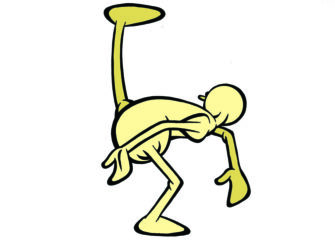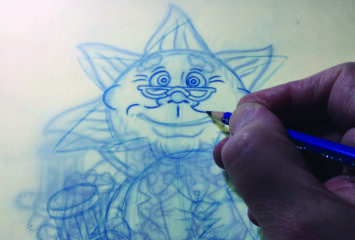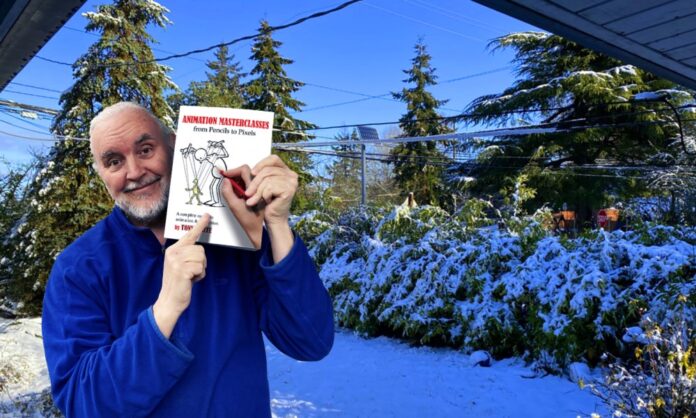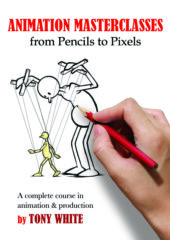“If you place a fully-trained animator on a computer, they’ll amaze you with how well they can bring inanimate characters to life. If you put an untrained animator on a computer however, all you’ll get is moving shapes. The challenge of the digital age is not to learn software first and foremost, but to learn how to make things move well before touching a computer.”
I write this at the beginning of my book, Animation Masterclasses: From Pencils to Pixels, with the utmost conviction and belief. Yes, I am amazed, inspired and very grateful for new animation technology that graces our world today. In the past — that is, in the “Golden Years” era of Disney and Warner Brothers, when character animation was at its peak — if you wanted to make an animated movie you would need a huge building, with hundreds of people and masses of equipment. The results were incredible of course — and some of the finest (and most profitable) films were created during this era. However, such approaches are no longer possible, or even desirable, in this digital age. Today you can, in theory, do the entire thing on your own computer and in your own home! Such a reality remains totally mind blowing to a veteran animator like myself — who actually trained with the giants of the past, one on one, and have taken all they taught me then and have run with it in new and innovative ways ever since. These things, I now seek to teach you through this book.
Yet, with great technical advancements come significant challenges too. Not least among these is the fact that although it is theoretically possible for an untrained individual to pick up state-of-the-art software, watch YouTube videos and create animated movement, they inevitably fall far short when asked to create true character animation, which moves convincingly and with weight, grace and expressing real feelings or emotions. One look at animation on TikTok or Instagram will immediately underline this. We no long train “artists,” and therefore we no longer equip animators to live up to the master animators of the past. The reason is so simple: Without traditional art skills and without knowing the core principles of movement, most of what is created with our amazing new technology is superficial and unsustainable in a longer format. In short, social media animation — even TV animation — is so far removed from the best and most outstanding of animated performances, achieved in the past with little technology at all.

Animation Masterclasses: From Pencils to Pixels addresses this. It seeks to fill that huge vacuum of real knowledge that exists in the animation world today. So many books teach animation technology but almost none teach techniques anymore — leaving me to wonder if many of the authors actually know how to make things move well themselves. With this book I have tried to get as close as I can to an invaluable apprenticeship in animation as I can — the kind I had in my early days in the industry. I have tried to pack its 808 pages with everything I know, everything I have experienced, and everything I have taught ever since. The book honors that amazing knowledge I received from the greats of the past, while respecting the techniques of the present and, hopefully, preparing students to become the master animators of the future. In that sense, I am without a doubt that “old man who plants trees in whose shade I will never sit.”

The book is structured in four sections, with each section containing 12 masterclasses that will teach, challenge and offer up essential assignments. In this way a student will be able to pick it up, knowing absolutely nothing about animation and then, at the end all it’s 48 masterclasses, will have made their own animated film. The book’s four sections are:
Section 1) Communicating many of the core principles of movement, using traditional hand-drawn animation techniques.
Section 2) Communicating further core principles of movement, using rigged digital character techniques, using “Moho”.
Section 3) Developing a powerful film idea and seeing it through the time-honored stages of the film Pre-Production processes.
Section 4) Applying tried and tested Production techniques that make the completion of a quality animated film entirely achievable.

Each individual class begins with an “observation gesture drawing” assignment. I do this in the book and I do it in my live online classes, too. The seduction of AI (and associated digital age goodies) tempts us into believing that technology does everything and therefore traditional art skills, like drawing, are redundant. Yet nothing could be further from the truth! Computers do amazing things, yes. But, in the final analysis, they are still no more than glorified pencils for an animator. A pencil does not do the work for you, neither can software or a computer. It is the skills of the user that determines how good the work is. The quote at the top of this article saying everything!
All this is precisely why I always start my classes with observational gesture drawing. These are not to teach students how to draw, however. They are more to teach students how to “see,” then “interpret” what they see, then “communicate” what they see through timed gesture sketches. Without an “animator’s eye,” an animator will not create powerful keys — meaning they will never create great animation. This is why eye/brain/hand co-ordination gesture drawing is so essential.

So, Sections 1 and 2 of the book teach the core principles of movement that every master animator must know. The first section is taught using traditional, pencil & paper techniques — although, full disclosure, I now teach my live classes digitally, using RoughAnimator. Section 2 teaches further core principles, but with rigged characters, in Moho. Section 3 covers all the essential pre-production processes of film production — including idea creation, storyboarding (including the core principles of filmmaking), character design, concept art, character/background layouts, perspective, color theory, timing & staging and of course, final animatic creation. Section 4 then moves forward into production — where refined animation techniques, digital coloring, scene compositing, audio production & post-production, and even a little on promotion/marketing are covered.
Journeys from my desktop have taken me far and wide around this world, with quality of production always my priority. This has only been possible however, because I learned the solid foundations of animation from the very best, at the very beginning. These things became my springboard for so much. That is why Animation Masterclasses: From Pencils to Pixels provides readers with such an ideal foundation too — and for whatever form of animation they will do ultimately. I have never lost my deep love for animation. Indeed, I’m currently preoccupied in creating further “legacy projects” like my book. For me, it is essential to pay back to animation for the incredible gifts it has given me, and I will therefore never stop sharing what I know and have experienced in this way.
Happy animating!
Animation Masterclasses: From Pencils to Pixels is available now from CRC Press, currently discounted for the End of Year Sale at $47.89 (regular price $59.95). Order here.
Tony White is an award-winning animator, author and teacher based in Seattle, Washington. Having begun his career learning from 2D legends like Ken Harris, Art Babbitt and Richard Williams, White now runs his own 2D Academy and has authored best-selling textbooks including The Animator’s Workbook, The Animator’s Notebook, The Animator’s Sketchbook, Jumping Through Hoops: The Animation Job Coach and Animation from Pencils to Pixels.
Learn more about White’s projects at drawassic.com and connect with him via animakers.club.

Animation.’
All images courtesy of Tony White.







